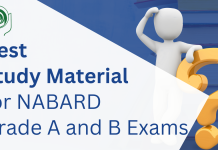The Reserve Bank of India (RBI) conducts a recruitment exam for the post of Grade B officers, known as the RBI Grade B exam. It is a highly competitive exam that requires strong knowledge of economics, finance, and general awareness. Clearing this exam is important for students who aspire to build a career in the banking and finance sector, as it is considered one of the most prestigious jobs in the industry. The RBI Grade B exam provides a gateway to other competitive exams such as Civil Services, Indian Economic Services, and other government job exams, making it a crucial step towards achieving career aspirations.
Quadratic Equation Questions for RBI Grade B Exam
The RBI Grade B exam has recently introduced a new pattern of Quadratic Equation questions. These questions require candidates to solve quadratic equations by using the given options, rather than by traditional methods of factoring or completing the square. This new pattern is aimed at testing a candidate’s ability to think logically, make accurate calculations, and utilize different problem-solving strategies.
Practicing quadratic equation questions is essential for success in the RBI Grade B exam. Studying quants series to hone your skills and learn to solve using various methods. Take a look at some difficult questions below with their solutions.
Read the following statement and answer the following questions.
Equation 1: ax2 + bx + c = 0
Equation 2: py2 + qy + c = 0
Given that:
=> c is a single digit prime number greater than 2.
=> p and b are 2-digit prime number less than 20.
=> p is greater than 11.
=> b is greater than p.
=> Smallest roots of both the equations are same
=> No root is irrational.
=> 3c is greater than b.
=> q= b + 1
1. Find the value of p2 + 2q.
- 200
- 219
- 209
- 229
- None of these
2. Find the value of a.
- 10
- 11
- 12.
- 15
- None of these
Read the following statement and answer the following questions.
HEquation 1: x2 – 7x + t = 0
Equation 2: y2 – 4y + (t – 9) =0
Roots of equation 1 are p and q and the roots of equation 2 are p and q – p.
3. Value of (t – 8)q?
- 256
- 206
- 236
- 246
- 276
4. Had equation 2 been multiplied with 2n and 1 been added to smallest root of the resultant quadratic equation newly formed then find the resultant number?
- 1
- 2
- 0
- 3
- None of these
Answer the questions based on the information given below.
Given below are two equations i.e. ‘I’ and ‘II’
Note:
i.) ‘x’ and ‘y’ are roots of equation ‘II’, such that x < y.
ii.) One of the roots of the equation ‘I’ is (-25).
5. Which of the following is the sum of values obtained by putting values of ‘p’ as roots of equation ‘II’ in the expression (p2 + 37p + 400)?
- 1787/4
- 1687/4
- 1887/4
- 1857/4
- None of these
6. Find the difference between roots of equation I
- 10
- 12
- 13
- 14
- None of these
7. Find the value of m(3/2) + √(225)
- 1015
- 1005
- 1115
- 1215
- None of these
Answer the questions based on the information given below.
Equation A: (a × a) – 3a – √(4a2) = – 6
Equation B: (b2) – √(81b2) = – 4 × (5)
Equation C: (c2 √625c6) / 5c3 + (4 × 7) = 39c
Equation D: d2 – (3 × 5)d = (7 × (-8) )
8. Find the difference between the larger and smaller roots of equation A.
- 1
- 2
- -1
- 3
- None of these
9. Find the LCM of all the larger roots of equations A, B, C, D.
- 840
- 440
- 740
- 860
- None of these
10. In which of the following equations difference between larger and smaller root is 1.
- Only A and B
- Only B
- Only B and C
- Only A, B and D
- None of these
Solutions:
1. c.
From the given points:
c can be 3, 5 and 7
p can be 11, 13, 17 and 19
q can be 11, 13, 17 and 19
p > 11
b > p
3c > b => 3 x 7 > b => 21 > b, so we can say that value of c will be 7.
Now, we can form different cases from the above points
Given that, no roots are irrational, means that value of discriminant will be perfect square.
We can write discriminant as D = b2 – 4ac
From Equation 2: py2 + qy + c = 0
So, from Case I:
D = q2 – 4pc
=> (18)2 – 4 × 13 × 7 = 324 – 364 = -ve, so case I is not possible
From Case II:
D = q2 – 4pc
=> (20)2 – 4 × 13 × 7 = 400 – 364 = 36, this is perfect square, hence case II is possible.
From case III:
D = q2 – 4pc
=> (20)2 – 4 × 17 × 7 = 400 – 476 = -ve, so case III is also not possible.
so, p = 13, b = 19, q = 20 and c = 7.
=> 132 + 2 × 20 = 209
2. c.
From the given points:
c can be 3, 5 and 7
p can be 11, 13, 17 and 19
q can be 11, 13, 17 and 19
p > 11
b > p
3c > b => 3 x 7 > b => 21 > b, so we can say that value of c will be 7.
Now, we can form different cases from the above points
Given that, no roots is irrational, means that value of discriminant will be perfect square.
We can write discriminant as D = b2 – 4ac
From Equation 2: py2 + qy + c = 0
So, from Case I:
D = q2 – 4pc
=> (18)2 – 4 × 13 × 7 = 324 – 364 = -ve, so case I is not possible
From Case II:
D = q2 – 4pc
=> (20)2 – 4 × 13 × 7 = 400 – 364 = 36, this is perfect square, hence case II is possible.
From case III:
D = q2 – 4pc
=> (20)2 – 4 × 17 × 7 = 400 – 476 = -ve, so case III is also not possible.
Therefore, Equation 1: ax2 + bx + c = 0 can be written as,
ax2 + 19x + 7 = 0
Therefore, Equation 2: py2 + qy + c = 0 can be written as,
13y2 + 20y + 7 = 0
=> 13y2 + 13y + 7y + 7 = 0
=> 13y(y + 1) + 7(y + 1) = 0
=> (13y + 7)(y + 1) = 0
=> y = -7/13, -1
Smaller root = -1
Given that, smallest roots of both the equations are same, so putting x = -1 in eq 1,
ax2 + bx + c = 0
=> a (-1)2 + 19 × -1 + 7 = 0
=> a – 19 + 7 = 0
=> a = 12
3. a.
From equation 1:
p + q = 7 (sums of roots)
pq = t (product of roots)
Now, from equation 2
p + q – p = 4
so, q = 4
Now,
p + q = 7
p + 4 = 7
p = 3
so, p = 3 and q = 4
so, t = 12
so, equation 2 will be, y2 – 4y + (t – 9) = 0
y2 – 4y + 3 = 0
Required value = (12 – 8) 4 = 4 4 = 256
4. b.
From equation 1:
p + q = 7 (sums of roots)
pq = t (product of roots)
Now, from equation 2
p + q – p = 4
so, q = 4
Now,
p + q = 7
p + 4 = 7
p = 3
so, p = 3 and q = 4
so, t = 12
so, equation 2 will be, y2 – 4y + (t – 9) = 0
y2 – 4y + 3 = 0
ATQ:
When 2n is multiplied by equation 2
2n (y2 – 4y + 3) = 0
2n (y2 – 3y – y + 3) = 0
2n (y – 1)(y – 3) = 0
2n cannot be zero.
So, y = 1 and y = 3
y = 1 + 1 = 2
5. c.
We have; 2q2 + 9q = 18
=> 2q2 + 9q – 18 = 0
=> 2q2 + 12q – 3q – 18 = 0
=> 2q(q + 6) – 3(q + 6) = 0
=> (q + 6)(2q – 3) = 0
=> q = -6, q = (3/2)
Since, x < y, x = -6 and y = (3/2)
Since, -25 is a root of the give equation, the value of equation will be ‘0’, when we put ‘x’ = 25.
So, (-25)2 + (37 x -25) + (400 – m) = 0
=> 625 – 925 + 400 – m = 0
=> m = 100
Now, equation I become: p2 + 37p + 400 = 0
Roots of equation II = (-6) and (3/2)
So, value of equation (I), when x = -6 = (-6)2 + 37 x (-6) + 300 = 114
And, value of equation (I), when x = (3/2) = (3/2)2 + (37 x 3/2) + 300 = (1431/4)
So, required sum = 114 + (1431/4) = (1887/4)
6. c.
We have; 2q2 + 9q = 18
=> 2q2 + 9q – 18 = 0
=> 2q2 + 12q – 3q – 18 = 0
=> 2q(q + 6) – 3(q + 6) = 0
=> (q + 6)(2q – 3) = 0
=> q = -6, q = (3/2)
Since, x < y, x = -6 and y = (3/2)
Since, -25 is a root of the give equation, the value of equation will be ‘0’, when we put ‘x’ = 25.
So, (-25)2 + (37 x -25) + (400 – m) = 0
=> 625 – 925 + 400 – m = 0
=> m = 100
Now, equation I become: p2 + 37p + 400 = 0
Equation I = p2 + 37p + 300 = 0
=> p2 + 25p + 12p + 300 = 0
=> p(p + 25) + 12(p + 25) = 0
=> (p + 25)(p + 12) = 0
So, p = -25 and p = -12
So, required value = (-12) – (-25) = 13
7. a.
Common sol:
We have; 2q2 + 9q = 18
=> 2q2 + 9q – 18 = 0
=> 2q2 + 12q – 3q – 18 = 0
=> 2q(q + 6) – 3(q + 6) = 0
=> (q + 6)(2q – 3) = 0
=> q = -6, q = (3/2)
Since, x < y, x = -6 and y = (3/2)
Since, -25 is a root of the give equation, the value of equation will be ‘0’, when we put ‘x’ = 25.
So, (-25)2 + (37 x -25) + (400 – m) = 0
=> 625 – 925 + 400 – m = 0
=> m = 100
Now, equation I become: p2 + 37p + 400 = 0
Required value = (100)3/2 + √ (225) = (102)3/2 + 15 = 1000 + 15 = 1015
8. a.
First, we will simplify the equation and find the roots of these quadratic equation:
A: (a × a) – 3a – √(4a2) = – 6
=> a2 – 3a – 2a + 6 = 0
=> a2 – 5a + 6 = 0
=> a2 – 3a – 2a + 6 = 0
=> a = 3, 2
B: (b2) – √(81b2) = – 4 × (5)
=> b2 – 9b + 20 = 0
=> b2 – 5b – 4b + 20 = 0
=> b = 5, 4
C: (c2 √625c6) / 5c3 + (4 × 7) = 39c
=> {c2 × 25c3}/5c3 – 39c + 28 = 0
=> 5c2 – 39c + 28 = 0
=> 5c2 – 39c + 28 = 0
=> 5c2 – 35c – 4c + 28
=> c = 7, 0.8
D: d2 – (3 × 5)d = (7 × (-8))
=> d2 – 15d + 56 = 0
=> d2 – 8d – 7d + 56 = 0
=> d = 8, 7
Now,
Required difference = 3 – 2 = 1
9. a.
First, we will simplify the equation and find the roots of these quadratic equation:
A: (a × a) – 3a – √(4a2) = – 6
=> a2 – 3a – 2a + 6 = 0
=> a2 – 5a + 6 = 0
=> a2 – 3a – 2a + 6 = 0
=> a = 3, 2
B: (b2) – √(81b2) = – 4 × (5)
=> b2 – 9b + 20 = 0
=> b2 – 5b – 4b + 20 = 0
=> b = 5, 4
C: (c2 √625c6) / 5c3 + (4 × 7) = 39c
=> {c2 × 25c3}/5c3 – 39c + 28 = 0
=> 5c2 – 39c + 28 = 0
=> 5c2 – 39c + 28 = 0
=> 5c2 – 35c – 4c + 28
=> c = 7, 0.8
D: d2 – (3 × 5)d = (7 × (-8))
=> d2 – 15d + 56 = 0
=> d2 – 8d – 7d + 56 = 0
=> d = 8, 7
Now,
LCM of all the larger roots of equations A, B, C, D = 3 × 5 × 7 × 8 = 840
10. d.
First, we will simplify the equation and find the roots of these quadratic equation:
A: (a × a) – 3a – √(4a2) = – 6
=> a2 – 3a – 2a + 6 = 0
=> a2 – 5a + 6 = 0
=> a2 – 3a – 2a + 6 = 0
=> a = 3, 2
B: (b2) – √(81b2) = – 4 × (5)
=> b2 – 9b + 20 = 0
=> b2 – 5b – 4b + 20 = 0
=> b = 5, 4
C: (c2 √625c6) / 5c3 + (4 × 7) = 39c
=> {c2 × 25c3}/5c3 – 39c + 28 = 0
=> 5c2 – 39c + 28 = 0
=> 5c2 – 39c + 28 = 0
=> 5c2 – 35c – 4c + 28
=> c = 7, 0.8
D: d2 – (3 × 5)d = (7 × (-8))
=> d2 – 15d + 56 = 0
=> d2 – 8d – 7d + 56 = 0
=> d = 8, 7
Now,
In A, B and D equations difference between larger and smaller root is 1.
To help you prepare 50% faster for competitive exams, ixamBee provides free Mock Test Series and all the Current Affairs in English and Current Affairs in Hindi in the BeePedia capsules for GA Preparation. You can also get the latest updates for Bank PO, Bank Clerk, SSC, RBI NABARD and Other Government Jobs.
Conclusion
If you have set your sights on clearing the RBI Grade B exam in 2023, then you must prioritize your preparation for quadratic equations with ixambee RBI Grade B Syllabus. It is vital to comprehend the question pattern on this topic thoroughly if you wish to score well in the exam. In order to achieve a high score and excel in the test, it is crucial to gain a strong grasp of the quadratic equations. With the right study plan and consistent practice offered by ixamBee, you can enhance your likelihood of success and secure your dream job.
Read Also
New pattern Question on Series For RBI Grade B exam
From Preparation to Performance: Roshan’s Tips for Acing the RBI Grade B Exam















